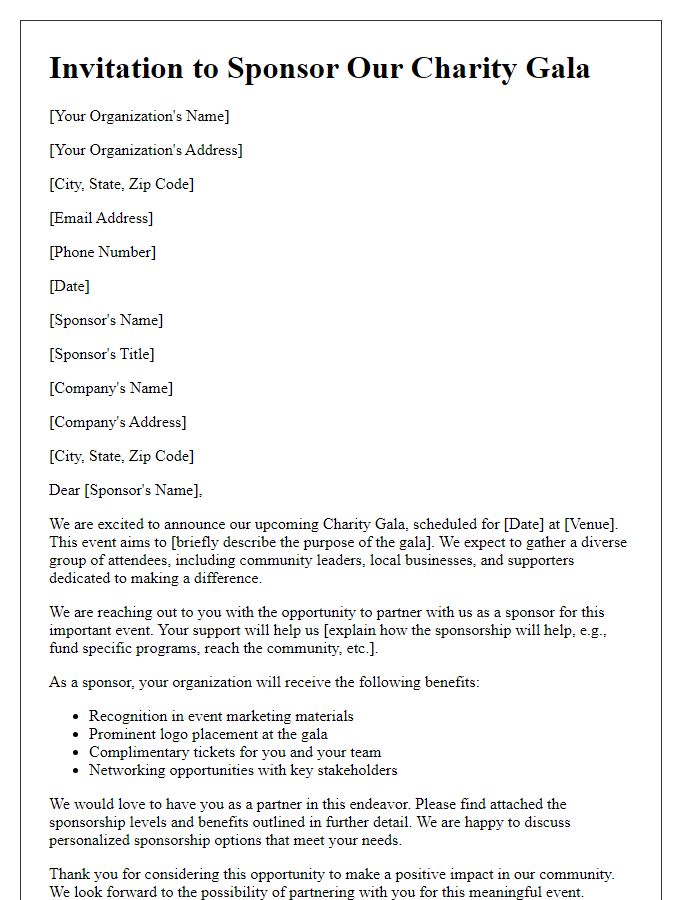Crafting a compelling sponsorship proposal for a non-profit can truly make a difference in how potential partners perceive your mission. With the right approach, you can showcase the unique impact your organization has on the community and how a partnership can amplify those efforts. In this article, we'll guide you through creating an engaging letter template that highlights your goals, values, and the benefits of sponsorship, ensuring you connect effectively with potential sponsors. So, let's dive in and explore how to create a proposal that resonates!

Purpose and Mission Alignment
A non-profit organization's mission typically focuses on serving community needs, addressing social issues, or promoting education and health initiatives. Clear alignment with potential sponsors' values or corporate social responsibility (CSR) goals is crucial for partnership success. For example, a local food bank might seek sponsorship from a grocery chain that emphasizes commitment to hunger relief and sustainable food sourcing. Highlighting collaborative community events such as fundraising drives or awareness campaigns can showcase shared objectives. Demonstrating measurable impact, like the distribution of over 500,000 meals annually or founding programs that reach 1,200 families in need, solidifies partnership potential. Engaging stakeholders through joint initiatives or corporate volunteering opportunities can further strengthen mission alignment and community involvement.
Clear Description of Benefits
Non-profit organizations often seek sponsorship to support their missions and initiatives, presenting an opportunity for businesses to align with meaningful causes. Sponsorship benefits can include enhanced brand visibility through event marketing, access to a passionate audience, tax deductions due to charitable contributions, and positive public relations. Businesses benefit from increased community goodwill by supporting local initiatives, which can enhance customer loyalty and employee engagement. Participation in non-profit events also offers networking opportunities with other sponsors and stakeholders, paving the way for potential partnerships and collaborations. In recognition of support, non-profits can provide sponsors with promotional activities, such as logos on event materials, mentions in press releases, and social media shout-outs, maximizing exposure and reinforcing brand integrity.
Target Audience and Impact
Non-profit organizations targeting communities in need often seek sponsorship to amplify their impact. For example, programs aimed at underprivileged youth in urban areas, like Los Angeles, can significantly benefit from corporate sponsorship. By collaborating with local businesses, these initiatives can extend educational resources, mentorship opportunities, and skill development workshops. The potential reach includes hundreds of students, with an emphasis on fostering personal growth and community engagement. Sponsorship from corporations can provide essential funding, helping to cover costs related to event organization, materials, and qualified instructors. The tangible outcomes not only enhance the lives of participants but can also reinforce the sponsoring company's commitment to social responsibility within the community.
Sponsorship Levels and Recognition
Sponsorship levels play a critical role in supporting non-profit organizations, enabling them to amplify their impact on communities. Various tiers of sponsorship may include Gold, Silver, and Bronze, each with distinct contribution amounts, often ranging from $10,000 to $1,000, offering different benefits like logo placement and promotional opportunities. Recognition can occur in numerous ways, such as featuring sponsors on websites, social media channels, and during events, which can include annual galas or community outreach programs, enhancing visibility and community engagement. Furthermore, personalized acknowledgments in press releases and newsletters can elevate a sponsor's profile, reflecting their commitment to social responsibility and community involvement.
Call to Action and Follow-up Plan
Crafting a compelling sponsorship proposal requires clear communication of your non-profit's mission and the specific benefits of collaboration. A call to action should motivate potential sponsors to engage with your organization by outlining the immediate steps they can take, such as scheduling a meeting or providing necessary information to begin the partnership process. This should be followed by a concrete follow-up plan detailing specific timelines (for example, a follow-up call one week after the proposal is sent) and methods of communication (such as email or phone). Highlighting the anticipated outcomes and shared goals strengthens the appeal and encourages active participation.
Letter Template For Non-Profit Sponsorship Proposal Samples
Letter template of non-profit sponsorship appeal for fundraising campaign.

Letter template of non-profit sponsorship inquiry for corporate partnership.

Letter template of non-profit sponsorship proposal for educational program.

Letter template of non-profit sponsorship solicitation for local project.

Letter template of non-profit sponsorship outreach for sports initiative.

Letter template of non-profit sponsorship communication for awareness campaign.

Letter template of non-profit sponsorship invitation for volunteer event.







Comments